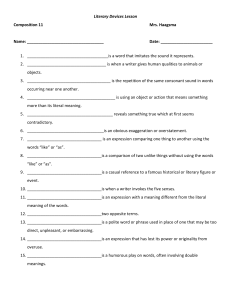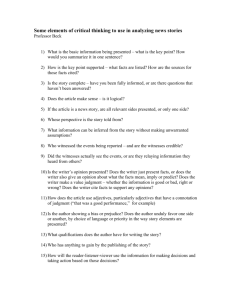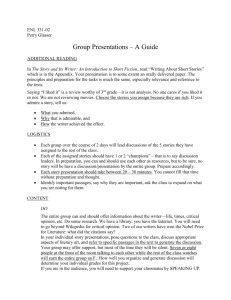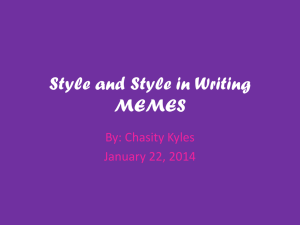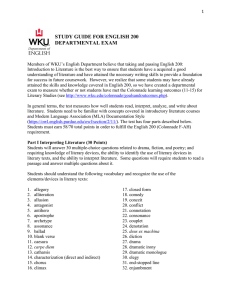Literary Terms - WordPress.com
advertisement
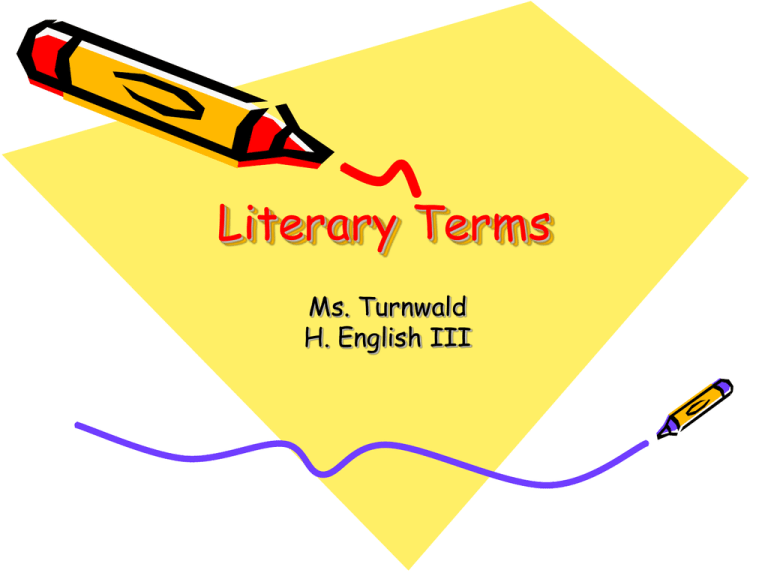
Literary Terms Ms. Turnwald H. English III Allegory Story or poem that has two levels. The 1st level is the story as it reads literally. The 2nd is where the story acts as a symbol with greater meaning • Examples: The Crucible is an allegory for McCarthyism. “The Pit & The Pendulum” allegorically represents hell, purgatory, & heaven. Alliteration • Repetition of the same constant sound in close proximity within a text. • Examples: “Peter Piper picked a peck of pickled peppers.” “A better butter makes a batter better.” Ambiguity - When something is capable of being interpreted in more than one way. Often used by writers to make the reader decide what happens in the story. • In “The Lady, or the Tiger” the author ends the story without telling which door the main character chose, leaving it to the reader. Analogy • A comparison made between two different things to show a similarity between them. • Example: Just as the sword is the weapon of a warrior, a pen is the weapon of a writer. Antonym - A word opposite in meaning to another. Examples: • Night/Day • Full/Empty • Vast/Miniscule • Beautiful/Ugly • Fascinating/Boring Apostrophe - Speaker of character rhetorically addresses an imaginary character or object. Helps the audience understand state of mind. Examples: • Macbeth speaks to the dagger he believes is floating in front of him. • John Donne talks to death in “Death Be Not Proud” Archetype • A typical character, setting, plot, or action which represents a universal concept or aspect of human nature. Examples: • The Hero • The Villain • The Wise Friend • The Damsel Saved from Distress • The Journey Audience The person reading a text, listening to a speaker, or observing a performance. Ex: A father reads to his daughter. (the daughter is the audience) Bias A preference of attitude that may prevent impartial judgment. Author may prejudice the audience in favor of one side of an issue. • Example: When an article uses all positive or negative language about a subject based on the writer’s interests/opinions. Characterization • Step by step processing of introducing and describing a character. Can be direct or indirect. • EX: Gatsby lives in West Egg which tells us he is from new money. Concrete Imagery - Usage of descriptive words that involve little or no abstraction or meaning beyond the literal one. • EX: A flag is a flag. A pencil is a pencil. Conflict A struggle between two or more opposing forces or characters. EXAMPLES: Two characters about to fight. A man battles the forces of nature. Connotation - A meaning implied by a word or text apart from its literal meaning. Cultural/emotional associations. • A character breeds doves and the reader gathers the connotation that the character is a peaceful individual. Context The surrounding word(s) and sentence(s). Information beyond the words of a text (economic, social, cultural, historical, etc.) Knowing about treatment of women in Victorian England provides context for understanding Jane Eyre. Contradiction - When two statements don’t seem to agree with each other. Counterargument • An opposing point of view to another argument. • By addressing counterargument before your opponent brings it up you may win favor for your argument. Deductive Reasoning • To draw a specific conclusion from general principles or premises. • Example: All birds have feathers. Robins are birds. Robins have feathers. Dialogue - Literary technique where two or more characters engage in conversation with each other. Denotation - The dictionary meaning of a word. EX: Love– (noun) a profoundly tender, passionate affection for another person. http://dictionary.reference.com/browse/ love Duality Opposite Objects/Concepts appearing within one story/character. Nature > Science Good > Evil Slavery > Freedom Reality > Illusion Inductive Reasoning - Reasoning which takes specific information and makes a broader generalization Example: A student leaves for school at 7:30. The student is always on time. The student assumes that if they always leave at 7:30 he/she will always be on time. Inversion The reversal of the normal word order of words in a sentence or phrase in order to achieve a specific effect of meter. Example: Wordsworth wrote, “To me alone there came a thought of grief.” Irony • Words you use to express something other than /opposite of literal meaning (verbal, situational, dramatic) Mood Literary element that evokes certain feelings in readers through words and descriptions. Example: When the character was dying I felt so distressed. Onomatopoeia The use of a word whose sound imitates or suggests its meaning. Examples: BANG! Boom! Zip. Meow. Oxymoron • A figure of speech that combines opposite or contradictory terms in a brief phrase. Examples: Seriously funny Foolish wisdom Original copies Jumbo shrimp Paradox A statement that may appear selfcontradictory but actually contains a truth. “War is peace.” -1984 “I must be cruel to be kind.” -Hamlet Parallelism The use of components in a piece of writing that are grammatically the same, or similar in their construction, sound, or meaning. Example: “Weep, weep” -Keats “Easy come, easy go” Paraphrase • A restatement of a text giving the meaning in one’s own words. Parody A work that makes fun of another work by imitating some aspect of the writer’s style . Examples: Comedy Central parodies political speeches frequently. Personification - A figure of speech in which an object or animal is given human feelings, thoughts, or attitudes . Examples: The wind whispered its secrets. Time waits for no man. The dust danced across the ray of sun. Perspective Literary tool which serves as a lens through which readers observe characters and events. Example: If the story is told from the perspective of a child versus an adult it changes the way we understand the story. Plot • A series of related events in a story or play, sometimes called the story line. The structure of a novel depends on the organization of the plot. • -Exposition –Conflict –Rising Action -Climax –Falling Action -Resolution Point of view -The vantage point from which the writer tells a story. (first person, third person limited, omniscient, and objective) Propaganda - The spreading of rumors, true or false, or an idea in order to influence the opinion of society or to further/damage a cause. Examples: • During war leaflets were dropped with messages for/against certain forces. • Ads that imply that buying a product will make you happy. Realism - A style of writing, developed in the nineteenth century, that attempts to depict life accurately, as it is real, without idealizing or romanticizing. Ex: Mark Twain’s “Adventures of Huck Finn” portrays real life in the South. Rhetorical Devices - Techniques writers use to enhance arguments and make their writing effective. Romanticism - A revolt against rationalism that affected literature and other arts, beginning in the late eighteenth century and remaining strong throughout most of the nineteenth century. Satire A type of writing that ridicules short comings of people or institutions in an attempt to bring about a change Ex: Twain’s “The Lowest Animal” and “Advice to Youth”. Swift’s “A Modest Proposal”. Style • The distinctive way in which a writer uses language Synonym - A word having the same or nearly the same meaning as another in the language. Examples: • Small/tiny • Large/huge • Beautiful/gorgeous • Terrible/awful Syllogisms - A logical scheme of a formal argument which references something general and from that draws conclusions about something specific. Theme A broad idea, message, or underlying meaning conveyed by a work. • The theme of isolation’s negative impact is demonstrated in Grendel. Tone • The attitude a writer takes toward the subject of his/her work . • “The Catcher in the Rye” has a bitterly sarcastic tone. Turn (Volta) • A shift or dramatic change in thought or emotion within a poem (specifically the sonnet). Understatement Making a large issue seem small. Often used as a device in satire. Example: Mercutio says that his injury is a “scratch” though he is actually bleeding to death. >
